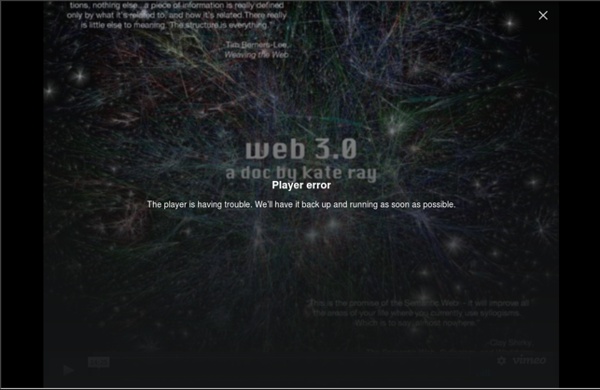



Vers un web 3.0 ? A peine le web 2.0 et ses concepts disruptifs commence-t-il à révéler son réel potentiel que l’on commence déjà à parler de la prochaine itération : le web 3.0. Ce mystérieux web 3.0 est-il une réalité aujourd’hui ? Non, pas du tout. L'industrie s'empare du web sémantique - Informatique REPÈRES Encore invisibles pour les internautes, les technologies du web sémantique permettent à des centaines de bases de données dans le monde de s’interconnecter et d’agréger leurs informations. La recherche médicale l’utilise déjà. L'aérospatial s'y met. Après la recherche médicale, l’aérospatial.
What is the Semantic Web really all about? The Semantic Web is based on the relatively straightforward idea that to be able to integrate (link) data on the Web we must have some mechanism for knowing what relationships hold among the data, and how that relates to some “real world” context. The following is a lot of detail that comes from this simple idea. To answer this question properly, let me start back in the early Web era. While I’m going to do some potentially boring personal history, I’ll note the key ideas as I go along. Circa 1995, my research group began playing with an idea (first proposed by my then student Sean Luke now a faculty member at GMU) that if web markup (it was all HTML back then) contained some machine readable “hints” to the computer, then we could do a better job of Web tasks like search, query, and faceted browsing.
Products: Snagit Screen Capture, Camtasia Studio Screen Recorder, Morae Usability Software from TechSmith Meet the Suite TechSmith’s suite of screen recording and video editing tools lets you make great content and collaborate with anyone. Communicate clearly, show what you know, and easily access your content wherever you are. Snagit Screen Capture and So Much More Use Snagit to provide better feedback, encourage teamwork, and create images that explain exactly what you mean.
Le web des données On pourrait définir le web des données comme étant le projet de rendre le web (et les informations qu’il véhicule) aussi aisément lisible et exploitable par des ordinateurs que par des êtres humains, en faisant sauter les spécificités de structuration des données propres à chaque base de données fournissant des informations sur internet. Etant donné qu’il naît de plusieurs frustrations dans le fonctionnement du web "normal", et que sa dénomination suscite souvent des incompréhensions, peut-être est-il bon de commencer par là. Les problèmes de compréhension Pour comprendre ce qu’est le web des données, on aimerait pouvoir voir ce qu’il permet de faire.
IsaViz Overview News IsaViz and Java 1.6 (2007-10-21) IsaViz 2.x is not compatible with Java 1.6 or later. It is recommended to download IsaViz 3.0 which does work with any version of Java. An alpha release is available (see Download section), which should be as stable as IsaViz 2.1 except for the new, still under development, Fresnel and FSL features. IsaViz and GraphViz (2007-05-23) The State of Linked Data in 2010 In May last year we wrote about the state of Linked Data, an official W3C project that aims to connect separate data sets on the Web. Linked Data is a subset of the wider Semantic Web movement, in which data on the Web is encoded with meaning using technologies such as RDF and OWL. The ultimate vision is that the Web will become much more structured, which opens up many possibilities for "smarter" Web applications. At this stage last year, we noted that Linked Data was ramping up fast - evidenced by the increasing number of data sets on the Web as at March 2009. Fast forward a year and the Linked Data "cloud" has continued to expand.
Semantic Web FAQ The term “rules” in the context of the Semantic Web refers to elements of logic programming and rule based systems bound to Semantic Web data. Rules offer a way to express, for example, constraints on the relationships defined by by RDF, or may be used to discover new, implicit relationships. Various rule systems (production rules, Prolog-like systems, etc) are very different from one another, and it is not possible to define one rule language to encompass them all. However, it is possible to define a “core” that is essentially understood by all rule systems. This core is based on restricted kind of rule, called a “Horn” rule, which (like most rules) has the form “if conditions then consequence”, but it places certain restrictions on the kinds of conditions and consequences that can be used.
It's All Semantics: Open Data, Linked Data & The Semantic Web Yesterday we summarized some of the main developments in the Linked Data world over the past year. Linked Data is a W3C-backed movement that is all about connecting data sets across the Web. It can be viewed as a subset of the wider Semantic Web movement, which is about adding meaning to the Web. Graphviz - Graph Visualization Software